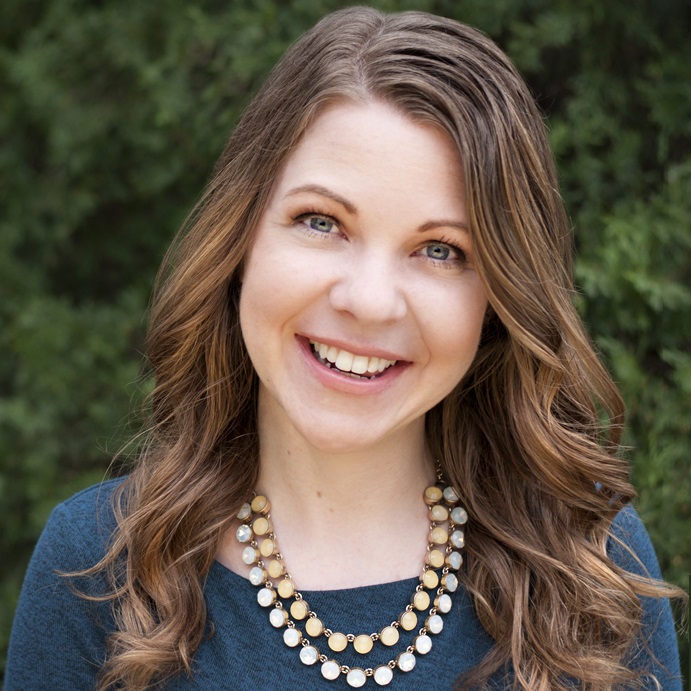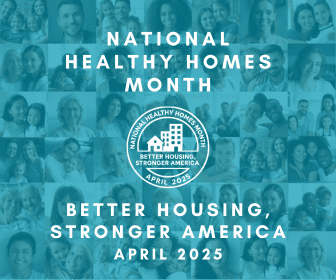Better Housing Means a Healthier, Stronger America: Why National Healthy Homes Month Matters More than Ever
by Amanda Reddy
Nobody was laughing. Last Tuesday, in a move that shocked public health advocates nationwide, the CDC announced sweeping layoffs suggesting the elimination of key healthy homes and environmental health programs. Many of us hoped it was a cruel April Fool’s joke.
In the hours between when I first heard an unofficial rumor about the scope of the layoffs and the first official headlines appearing about it, I thought to myself, “This is the first day of National Healthy Homes Month. We’re supposed to be celebrating, not grieving.” And then as I talked to staff, board members, partners, and communities throughout the day, I realized that the way we need to celebrate and the way we need to grieve is exactly the same: We need to continue to talk about why the right to a safe and healthy place to live is an essential, nonpartisan human right, not to mention both a moral and economic imperative. In fact, this is the time to turn up the volume on that message. Why? Because…
- Ten people die of asthma every day in this country, and most of those deaths are preventable. Millions more with asthma are impacted by environmental conditions that make it hard to go to school or work or fully exercise their right to a pursuit of happiness.
- Half a million children in the U.S. (that’s nearly 24,000 kindergarten classrooms full of kids) have been exposed to levels of lead that can compromise their ability to learn and thrive. Adults aren’t immune, either—millions are affected by lead exposure, and a recent study estimated that lead kills 5.5 million adults each year, making it a bigger global killer than AIDS, malaria, diabetes, and road traffic deaths combined. These exposures and the harm they cause are also largely avoidable.
- Sixty million American residents live in rural areas, occupying an estimated 29 million homes. Over 1.4 million of these homes are severely or moderately inadequate, and over 11.5 million rural homes have health and safety hazards, such as pests, peeling paint (which may contain lead hazards), water leaks, foundation problems, and mold. About 22% of rural adults worry about the conditions of their homes affecting their family’s health or safety.
- Poor indoor air quality doesn’t just cause kids to miss school because of asthma attacks or make your allergies year-round instead of seasonal. It also kills. Approximately 21,000 Americans die each year from radon-related lung cancer deaths, and more than 400 Americans die from unintentional carbon monoxide poisoning each year. And that doesn’t even begin to account for the fact that those asthma attacks can also be deadly, that heart conditions can also be exacerbated by poor indoor air quality, or that tens of thousands more people have to miss work and school to go to emergency departments and doctor’s offices every year simply because of where they live.
- Poor housing quality may also be associated with higher rates of infectious disease or worse mental health—did you know this? A study conducted in the first year of the COVID-19 pandemic found that counties with higher rates of poor housing quality had higher rates of COVID and higher COVID mortality, even when controlling for other risk factors. With regard to mental health, another study found that poor housing quality was most consistently associated with children’s and adolescents’ development, including worse emotional and behavioral functioning and lower cognitive skills—even more so than housing stability, type, and cost.
- A majority of our growing older adult population wants to age safely and comfortably in their own homes. We know how to make this happen, but every 11 seconds an older adult is treated in the emergency room, and every 19 minutes an older adult dies. Many of these falls happen in and around homes, and many are preventable.
- We all watched in horror at the aftermath of historic flooding in North Carolina last fall and the devastating wildfires that recently ravaged southern California. These kinds of extreme weather events (not just floods and wildfires but also high wind events, extreme heat, extreme cold, and more) are increasing in their frequency and intensity. Last year, more than 70% of Americans were impacted by extreme heat alone. Housing is central to how we will weather these threats. It’s where most of us will take shelter, and it is imperative for us to make the investment to ensure that they are safe and healthy places for us to be so that we aren’t just exchanging one threat (a storm) for another (lead poisoning, CO poisoning).
- Investing in better housing doesn’t just save lives; it saves money, creates jobs, lowers utility bills, improves home values, and provides a lot of other returns that mean something to everyday Americans. Cutting programs looks good on a spreadsheet but fails to account for all the benefits they generate.
The bottom line? Illness, injury, and death resulting from exposure to poor housing quality and conditions is largely preventable and taking action to prevent it will also save us a lot of money. Whatever your political priorities or affiliation, investing in safe, affordable, resilient housing makes sense. This is an issue that can and should unite us.
It also hasn’t escaped our notice that although the federal government normally leads the charge on National Healthy Homes Month, those efforts appear to be on hold (whether temporarily or permanently). But here’s the thing: National Healthy Homes Month belongs to all of us. It’s always been enhanced by federal leadership, but it isn’t constrained by the absence of it. We hope that our federal partners will be able to join in again in the future; but in the meantime, we know that the healthy homes field is more than capable of carrying this water.
Better Housing, Stronger America
NCHH is choosing to celebrate this month with the theme “Better Housing, Stronger America.” As detailed above, better housing is a powerful platform for improving individual health and community strength. We also believe that everyone, everywhere deserves safe, resilient, and affordable housing, and our priority this month is the same as it is every day: to help secure healthy housing for all. The emphasis on a stronger America in our chosen theme is not an abdication of the importance of this work internationally; it simply reflects the national focus of this month and the unprecedented moment we’re at in our national conversation about what it means to make America stronger.
We hope that you’ll find a way to recognize healthy homes this month, too. If you already had plans, stick with them and let us know about them so we can help amplify your message. If you’re looking for a place to get started, here are some ideas:
- Whether you are an individual, a concerned parent, a nonprofit organization, or anyone else, one of the most important things you can do this month is to let your elected officials know that this is an issue that is important to you and your community. We have sample scripts you can use here.
- If you are a content creator or have a following on a social media platform, we hope you’ll take some time to talk about these issues. It’s okay if your message isn’t perfect—the healthy homes movement has always been a work in progress. And if you want help with key resources or talking points, reach out to our staff and ask.
- If you have a story about why safe and healthy housing is important, let us know! Maybe you have asthma, or your child was exposed to lead, or you had to ride out a climate-related event in housing that was not properly equipped to protect you, or you run or were impacted by a program that helped improve housing in your community. Stories can change hearts and minds and if you’re ready, we invite you to share yours here: https://nchh.org/build-the-movement/five-things/share-your-story/.
- Talk about it. On social media, at church, over dinner with the extended family, with other parents watching your kid’s baseball game—any chance you get. Talk about it from the heart and be okay with your message being imperfect (we know, we know, we’re working on that one, too!). The most important thing to do is to talk about why and how safe, affordable, and resilient housing matters to you, your community, and to our nation’s future.
The power of talking about the importance of these issues was on full display recently as the administration first announced, then began to walk back cuts to the CDC lead program. Whether you spoke to the press, helped get someone else equipped with talking points to speak to the press, reached out to elected officials, shared social media posts, or talked about your concerns in any way and in any forum, you helped focus attention on this mistake. And we’re not done yet. The fate of most of those programs at CDC is still unclear at best and other key federal investments are also at risk. Talking about the importance of safe housing and the fact that we have proven, shovel-ready, cost-effective, and scalable solutions also provides an opportunity for other types of investments from private foundations, healthcare payers, state and local governments, housing providers, and others who share our goal of building a healthier, stronger America and see the promise of investing in housing as a unifying strategy for achieving that vision.
So, hopefully the next question on your mind isn’t whether you should participate in National Healthy Homes Month 2025, but what will you be talking about? Whatever your answer, we hope you let us (and a bunch of other people!) know.
 Amanda Reddy, MS, Executive Director of the National Center for Healthy Housing, has advanced numerous initiatives, including those related to healthcare financing of healthy homes services, training and technical assistance to support the launch and growth of sustainable healthy homes programs, and the development of indicators for the HUD Healthy Communities Index. Prior to NCHH, Ms. Reddy was a research scientist with the New York State Department of Health, where she provided program evaluation, management, and technical support for the Asthma Control, Healthy Homes and Lead Poisoning Primary Prevention, Healthy Neighborhoods, and Healthy Home Environments for New Yorkers with Asthma programs. Ms. Reddy holds an MS in environmental health from the London School of Hygiene and Tropical Medicine and a BA in neuroscience from Mount Holyoke College.
Amanda Reddy, MS, Executive Director of the National Center for Healthy Housing, has advanced numerous initiatives, including those related to healthcare financing of healthy homes services, training and technical assistance to support the launch and growth of sustainable healthy homes programs, and the development of indicators for the HUD Healthy Communities Index. Prior to NCHH, Ms. Reddy was a research scientist with the New York State Department of Health, where she provided program evaluation, management, and technical support for the Asthma Control, Healthy Homes and Lead Poisoning Primary Prevention, Healthy Neighborhoods, and Healthy Home Environments for New Yorkers with Asthma programs. Ms. Reddy holds an MS in environmental health from the London School of Hygiene and Tropical Medicine and a BA in neuroscience from Mount Holyoke College.

